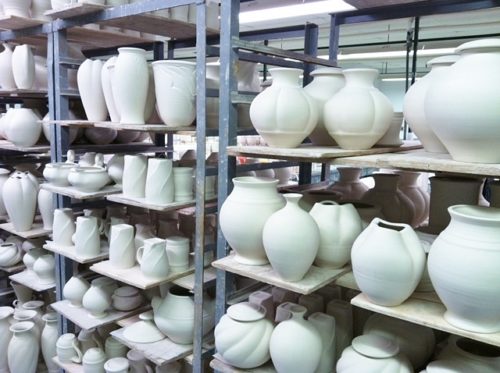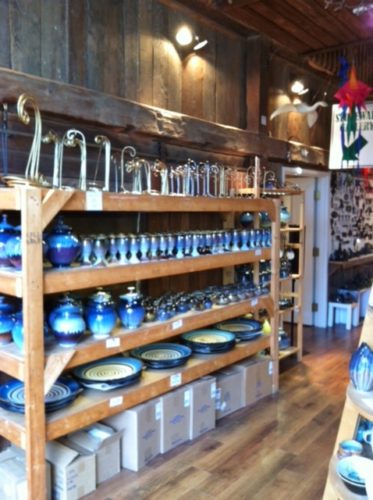by Carolyn Edlund
Wholesaling has distinct benefits for creative entrepreneurs whose work is appropriate for this market.

Shelves of ware in a production studio. Photo taken at Campbell Pottery.
If you have the ability to reproduce your work in multiples, do production work from your studio and want to cultivate repeat customers, you may be a good candidate for wholesaling. Creatives who both wholesale and retail find that these are complementary income streams which often provide year-round sales.
Artists and makers who sell at wholesale produce in the studio and ship to retailers of all types, who then mark up the price and sell to the public. These retailers may be craft galleries, gift shops, museum stores, boutiques, online vendors or others.
Store owners are looking for products that sell well consistently rather than having to frequently seek new lines. If your products are a success in their stores, you can count on repeat orders. Regular repeat orders provide a solid foundation for growing a business. As you gain more of these customers, your account base expands. Each new account you earn helps to diversify that base, thus making your income more stable and predictable. Many entrepreneurs have built full-time profitable businesses this way.

Finished work for sale in a retail craft gallery.
Benefits of Wholesaling
There are numerous advantages to this sales channel. It begins with designing a line (or collection) of products available to order. When orders are received, they are produced in the studio (or through a vendor creating reproductions for you) and shipped to your store customer. This process gives you the ability to leverage your designs. Creating in production is more efficient and cost-effective than making one-of-a-kind work. It streamlines the selling and making process, and can increase sales volume quickly.
Wholesale buyers place orders from viewing physical samples, line sheets, or catalogs. You don’t necessarily have to hold inventory in advance. Producing to order is not only more economical, but it also enables you to sell your work before it’s made!
When designing, consider how you can make your work collectable, to encourage multiple and/or repeat sales by retail customers. This tactic drives greater sales for your retailers, leading to larger and more frequent orders for your studio. Designing work in sets, series and groupings are perfect ways to maximize this potential.
Pricing for Wholesale
If you aren’t pricing your work correctly (no matter your sales channel), your business can go upside down rather quickly. It’s essential to know your costs, and use a formula that includes a decent profit margin. In production, you can easily gauge the cost of materials and labor per item. This allows you to price accurately. You will also want to add in the greatest margin that the market will bear for your goods to set a price for maximum profitability. Our e-course Pricing Strategies for Artists & Makers is a comprehensive guide to understanding pricing, and works well for those who wholesale.
Two parties earn from your production: you and your retail store customer. Their markup over your wholesale price covers their own costs and labor, and also includes a profit margin. When your products are a good fit, the prices of your work in their store are attractive, and the perceived value is high, sales will be brisk. As you learn over time what your bestsellers are, you can build even more saleable collections and recommend them to new wholesale buyers. This positions you for success with each new store added to your customer base.
Closing New Accounts
Retailers connect with artists and makers in several ways. They may attend trade shows, meet with sales reps, or use online trade portals to select new merchandise for their stores.
If you’re just starting out, you may call on local stores in person. This will enable you to show samples, share marketing collateral such as brochures, catalogs and line sheets, and discuss terms. These sales conversations can be incredibly valuable, because you will learn about your customer’s needs, get feedback and become more comfortable in business relationships.
Buyers may love your work personally, but if it’s not right for their own customers, they won’t place an order. If your line does interest them, they may not order right away. Perhaps they have spent their current budget, or they may want to watch your line to see how it evolves and make sure your small business is thriving before they invest in inventory.
Don’t give up when you find a good prospective retailer that is a good fit for your work, because it can take time to close the deal. But when you do, there is a good chance you will retain them as an ongoing customer. This is another great benefit of working in the wholesale channel. The customers you land today can become profitable and friendly partners for many years.


Speak Your Mind